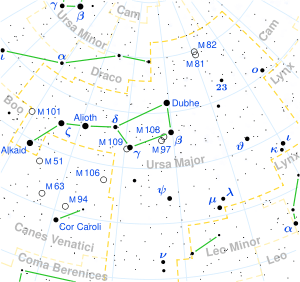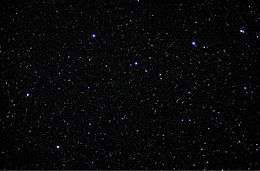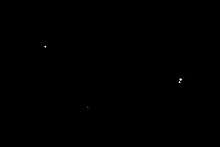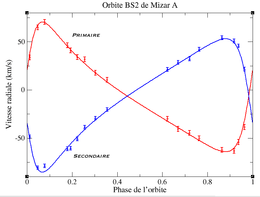Mizar
Mizar /ˈmaɪzɑːr/[15] is a second-magnitude star in the handle of the Big Dipper asterism in the constellation of Ursa Major. It has the Bayer designation ζ Ursae Majoris (Latinised as Zeta Ursae Majoris). It forms a well-known naked eye double star with the fainter star Alcor, and is itself a quadruple star system. The whole system lies about 83 light-years away from the Sun, as measured by the Hipparcos astrometry satellite, and is part of the Ursa Major Moving Group.
 | |
| Observation data Epoch J2000 Equinox J2000 | |
|---|---|
| Constellation | Ursa Major |
| Mizar | |
| Right ascension | 13h 23m 55.54048s[1] |
| Declination | +54° 55′ 31.2671″[1] |
| Apparent magnitude (V) | 2.04[2] |
| ζ1 UMa | |
| Right ascension | 13h 23m 55.543s[3] |
| Declination | +54° 55′ 31.30″[3] |
| Apparent magnitude (V) | 2.23[3] |
| ζ2 UMa | |
| Right ascension | 13h 23m 56.330s[3] |
| Declination | +54° 55′ 18.56″[3] |
| Apparent magnitude (V) | 3.88[3] |
| Characteristics | |
| ζ1 UMa | |
| Spectral type | A2Vp/A2Vp[4] |
| U−B color index | −0.01[5] |
| B−V color index | +0.02[5] |
| ζ2 UMa | |
| Spectral type | kA1h(eA)mA7IV-V[6] |
| U−B color index | +0.09[5] |
| B−V color index | +0.13[5] |
| Astrometry | |
| Radial velocity (Rv) | −6.31[7] km/s |
| Proper motion (μ) | RA: 119.01[1] mas/yr Dec.: −25.97[1] mas/yr |
| Parallax (π) | 39.36 ± 0.30[8] mas |
| Distance | 82.9 ± 0.6 ly (25.4 ± 0.2 pc) |
| Absolute magnitude (MV) | +0.32/+1.96[9] |
| Orbit | |
| Primary | Mizar Aa |
| Companion | Mizar Ab |
| Period (P) | 20.5386 days[10] |
| Semi-major axis (a) | 9.83±0.03[11] mas |
| Eccentricity (e) | 0.5415±0.0016[10] |
| Inclination (i) | 60.5±0.3[10]° |
| Longitude of the node (Ω) | 106.0±0.4[11]° |
| Periastron epoch (T) | RJD 54536.9904[10] |
| Argument of periastron (ω) (secondary) | 105.27±0.23[10]° |
| Semi-amplitude (K1) (primary) | 66.478±0.153[10] km/s |
| Semi-amplitude (K2) (secondary) | 66.019±0.177[10] km/s |
| Orbit | |
| Primary | Mizar Ba |
| Companion | Mizar Bb |
| Period (P) | 175.55 d[12] |
| Semi-major axis (a) | 29.849 mas |
| Eccentricity (e) | 0.46[12] |
| Details | |
| Mizar Aa | |
| Mass | 2.2224±0.0221[10] M☉ |
| Radius | 2.4 ± 0.1[11] R☉ |
| Luminosity | 33.3 ± 2.1[11] L☉ |
| Temperature | 9,000 ± 200[11] K |
| Age | 370[13] Myr |
| Mizar Ab | |
| Mass | 2.2381±0.0219[10] M☉ |
| Radius | 2.4 ± 0.1[11] R☉ |
| Luminosity | 33.3 ± 2.1[11] L☉ |
| Temperature | 9,000 ± 200[11] K |
| ζ2 UMa | |
| Surface gravity (log g) | 4.40[14] cgs |
| Temperature | 8,425[14] K |
| Rotational velocity (v sin i) | 61[14] km/s |
| Other designations | |
| ζ1 UMa: GC 18133, HD 116656, HR 5054, PPM 34007, SAO 28737 | |
| ζ2 UMa: GC 18134, HD 116657, HR 5055, SAO 28738 | |
| Database references | |
| SIMBAD | Mizar |
| ζ1 UMa | |
| ζ2 UMa | |
Nomenclature
ζ Ursae Majoris (Latinised to Zeta Ursae Majoris and abbreviated to ζ UMa or Zeta UMa) is Mizar's Bayer designation. It also has the Flamsteed designation 79 Ursae Majoris.
The traditional name Mizar derives from the Arabic المئزر miʼzar meaning 'apron; wrapper, covering, cover'.[16] In 2016, the International Astronomical Union organized a Working Group on Star Names (WGSN)[17] to catalog and standardize proper names for stars. The WGSN's first bulletin of July 2016[18] included a table of the first two batches of names approved by the WGSN; which included Mizar for ζ UMa. According to IAU rules, the name Mizar strictly only applies to component Aa,[19] although it is traditionally and popularly used for all four stars making up the single naked-eye star.[20][21]
Stellar system


Mizar is a visual double with a separation of 14.4 arcseconds, each of which is a spectroscopic binary. Its combined apparent magnitude is 2.04. The two visible stars are referred to as ζ1 and ζ2 Ursae Majoris, or Mizar A and B. The spectroscopic components are generally referred to as Mizar Aa, Ab, Ba, and Bb. The stars all share a single Hipparcos designation of HIP 65378, but separate Bright Star Catalogue and Henry Draper Catalogue entries. Mizar, together with Alcor and many of the other bright stars in Ursa Major, is a member of the Ursa Major Moving Group.[22]
An easily split visual target, Mizar was the first telescopic binary discovered, most probably by Benedetto Castelli who in 1617 asked Galileo Galilei to observe it. Galileo then produced a detailed record of the double star.[23] Later, around 1650, Riccioli wrote of Mizar appearing as a double.[24] The secondary star (Mizar B) comes within 380 AU of the primary (Mizar A) and the two take thousands of years to revolve around each other.[25]
Mizar A was the first spectroscopic binary to be discovered, as part of Antonia Maury's spectral classification work, and an orbit was published in 1890. Some spectroscopic binaries cannot be visually resolved and are discovered by studying the spectral lines of the suspect system over a long period of time. The two components of Mizar A are both about 35 times as bright as the Sun, and revolve around each other in about 20 days 12 hours and 55 minutes. In 1908, Mizar B was also found to be a spectroscopic binary, its components completing an orbital period every six months.[8] In 1996, 107 years after their discovery, the components of the Mizar A binary system were imaged in extremely high resolution using the Navy Prototype Optical Interferometer.[26]
ζ1 Ursae Majoris

The two components of ζ1 Ursae Majoris (Mizar Aa and Ab) are observed to be identical, with the exception of slightly different radial velocity variations which indicate very slightly different masses.
The spectral lines of the two stars can be observed separately and both are given a spectral type of A2Vp. They are Ap stars, chemically peculiar due to stratification of some heavy elements in the photosphere of slowly-rotating hot stars. In this case, they show elevated abundances of strontium and silicon.[27]
With the assumption of identical physical properties for the two stars, they both have temperatures of 9,000 K, radii of 2.4 R☉, and bolometric luminosities of 33.3 L☉.[11] They are thought to be around 370 million years old.[13]
ζ2 Ursae Majoris
ζ2 Ursae Majoris is a single-lined spectroscopic binary, and the visible spectrum is of an Am star, named for their unusually strong lines of some metals. The spectral type of kA1h(eA)mA7IV-V is in a form used for metallic-lined stars: the type is A1 based on the calcium K lines, early A based on the hydrogen lines, and A7 based on lines of other metals. The luminosity class is ranked between main sequence and subgiant.
Based on the orbital properties of the system, the total mass of the two stars is approximately 1.73 solar masses, most of which is contributed by the primary star. The secondary is a red dwarf.
Other names
Mizar is known as Vashistha one of the Saptarishi, in traditional Indian astronomy.[28] Chinese Taoism personifies ζ Ursae Majoris as the Lu star.[29]
In Chinese, 北斗 (Běi Dǒu), meaning Northern Dipper, refers to an asterism equivalent to the Big Dipper. Consequently, the Chinese name for ζ Ursae Majoris itself is 北斗六 Běi Dǒu liù, (English: the Sixth Star of Northern Dipper) and 開陽 Kāi Yáng, (English: Star of The Opener of Heat).[30]
Mizar is Chickadee and Alcor is his cooking pot in the Mi'kmaq myth of the great bear and the seven hunters.[31]
Military namesakes
- USS Mizar is a cargo and passenger liner converted to a United States Navy ship
- USNS Mizar, a United States Navy ship
See also
References
- van Leeuwen, F. (November 2007). "Validation of the new Hipparcos reduction". Astronomy and Astrophysics. 474 (2): 653–664. arXiv:0708.1752. Bibcode:2007A&A...474..653V. doi:10.1051/0004-6361:20078357.
- Mermilliod, J.-C (1986). "Compilation of Eggen's UBV data, transformed to UBV (unpublished)". Catalogue of Eggen's UBV Data. Bibcode:1986EgUBV........0M.
- Fabricius, C; Høg, E; Makarov, V. V; Mason, B. D; Wycoff, G. L; Urban, S. E (2002). "The Tycho double star catalogue". Astronomy and Astrophysics. 384: 180–189. Bibcode:2002A&A...384..180F. doi:10.1051/0004-6361:20011822.
- Eggleton, P. P.; Tokovinin, A. A. (2008). "A catalogue of multiplicity among bright stellar systems". Monthly Notices of the Royal Astronomical Society. 389 (2): 869–879. arXiv:0806.2878. Bibcode:2008MNRAS.389..869E. doi:10.1111/j.1365-2966.2008.13596.x.
- Iriarte, Braulio; Johnson, Harold L; Mitchell, Richard I; Wisniewski, Wieslaw K (1965). "Five-Color Photometry of Bright Stars". Sky and Telescope. 30: 21. Bibcode:1965S&T....30...21I.
- Gray, R. O; Garrison, R. F (1987). "The early a type stars - Refined MK classification, confrontation with Stroemgren photometry, and the effects of rotation". Astrophysical Journal Supplement Series. 65: 581. Bibcode:1987ApJS...65..581G. doi:10.1086/191237.
- Pourbaix, D; Tokovinin, A. A; Batten, A. H; Fekel, F. C; Hartkopf, W. I; Levato, H; Morrell, N. I; Torres, G; Udry, S (2004). "SB9: The ninth catalogue of spectroscopic binary orbits". Astronomy and Astrophysics. 424 (2): 727–732. arXiv:astro-ph/0406573. Bibcode:2004A&A...424..727P. doi:10.1051/0004-6361:20041213.
- Mamajek, Eric E.; Kenworthy, Matthew A.; Hinz, Philip M.; Meyer, Michael R. (2010). "Discovery of a Faint Companion to Alcor Using MMT/AO 5 μm Imaging". The Astronomical Journal. 139 (3): 919–925. arXiv:0911.5028. Bibcode:2010AJ....139..919M. doi:10.1088/0004-6256/139/3/919.
- King, Jeremy R; Villarreal, Adam R; Soderblom, David R; Gulliver, Austin F; Adelman, Saul J (2003). "Stellar Kinematic Groups. II. A Reexamination of the Membership, Activity, and Age of the Ursa Major Group". The Astronomical Journal. 125 (4): 1980. Bibcode:2003AJ....125.1980K. doi:10.1086/368241.
- Behr, Bradford B; Cenko, Andrew T; Hajian, Arsen R; McMillan, Robert S; Murison, Marc; Meade, Jeff; Hindsley, Robert (2011). "Stellar Astrophysics with a Dispersed Fourier Transform Spectrograph. II. Orbits of Double-lined Spectroscopic Binaries". The Astronomical Journal. 142 (1): 6. arXiv:1104.1447. Bibcode:2011AJ....142....6B. doi:10.1088/0004-6256/142/1/6.
- Hummel, C. A.; Mozurkewich, D.; Armstrong, J. T.; Hajian, Arsen R.; Elias Ii, N. M.; Hutter, D. J. (1998). "Navy Prototype Optical Interferometer Observations of the Double Stars Mizar a and Matar". The Astronomical Journal. 116 (5): 2536. Bibcode:1998AJ....116.2536H. doi:10.1086/300602.
- Iliev, I. Kh; Budaj, J; Zverko, J; Barzova, I. S; Ziznovsky, J (1998). "Lithium and metal abundances in long period AM binaries". Astronomy and Astrophysics Supplement. 128 (3): 497. Bibcode:1998A&AS..128..497I. doi:10.1051/aas:1998160.
- Thureau, N. D; Greaves, J. S; Matthews, B. C; Kennedy, G; Phillips, N; Booth, M; Duchêne, G; Horner, J; Rodriguez, D. R; Sibthorpe, B; Wyatt, M. C (2014). "An unbiased study of debris discs around A-type stars with Herschel" (PDF). Monthly Notices of the Royal Astronomical Society. 445 (3): 2558. Bibcode:2014MNRAS.445.2558T. doi:10.1093/mnras/stu1864.
- Monier, R (2005). "Abundances of a sample of a and F-type dwarf members of the Ursa Major Group". Astronomy and Astrophysics. 442 (2): 563–566. Bibcode:2005A&A...442..563M. doi:10.1051/0004-6361:20053222.
- Kunitzsch, Paul; Smart, Tim (2006). A Dictionary of Modern star Names: A Short Guide to 254 Star Names and Their Derivations (2nd rev. ed.). Cambridge, Massachusetts: Sky Pub. ISBN 978-1-931559-44-7.
- Wehr, Hans (1994). A Dictionary of Modern Written Arabic (Arabic-English) (4 ed.). Urbana, Illinois: Spoken Language Services. p. 17. ISBN 0879500034.
- "IAU Working Group on Star Names (WGSN)". International Astronomical Union. Retrieved 22 May 2016.
- "Bulletin of the IAU Working Group on Star Names, No. 1" (PDF). International Astronomical Union. Retrieved 28 July 2016.
- "IAU Catalog of Star Names". International Astronomical Union. Retrieved 28 July 2016.
- Richard H. Allen (28 February 2013). Star Names: Their Lore and Meaning. Courier Corporation. ISBN 978-0-486-13766-7.
- Guy Consolmagno; Dan M. Davis (19 October 2000). Turn Left at Orion: A Hundred Night Sky Objects to See in a Small Telescope - and How to Find Them. Cambridge University Press. pp. 83–. ISBN 978-1-139-45750-7.
- Jones, Jeremy; White, R. J; Boyajian, T; Schaefer, G; Baines, E; Ireland, M; Patience, J; Ten Brummelaar, T; McAlister, H; Ridgway, S. T; Sturmann, J; Sturmann, L; Turner, N; Farrington, C; Goldfinger, P. J (2015). "The Ages of A-Stars. I. Interferometric Observations and Age Estimates for Stars in the Ursa Major Moving Group". The Astrophysical Journal. 813 (1): 58. arXiv:1508.05643. Bibcode:2015ApJ...813...58J. doi:10.1088/0004-637X/813/1/58.
- Michael Marett-Crosby (28 June 2013). Twenty-Five Astronomical Observations That Changed the World: And How To Make Them Yourself. Springer Science & Business Media. pp. 32–. ISBN 978-1-4614-6800-4.
- Steven J. Dick (9 September 2013). Discovery and Classification in Astronomy: Controversy and Consensus. Cambridge University Press. pp. 117–. ISBN 978-1-107-03361-0.
- Robert Burnham (1978). Burnham's Celestial Handbook: An Observer's Guide to the Universe Beyond the Solar System. Courier Corporation. ISBN 978-0-486-23673-5.
- Benson, J. A; Hutter, D. J; Elias, N. M; Bowers, P. F; Johnston, K. J; Hajian, A. R; Armstrong, J. T; Mozurkewich, D; Pauls, T. A; Rickard, L. J; Hummel, C. A; White, N. M; Black, D; Denison, C. S (1997). "Multichannel optical aperture synthesis imaging of zeta1 URSAE majoris with the Navy prototype optical interferometer". Astronomical Journal. 114: 1221. Bibcode:1997AJ....114.1221B. doi:10.1086/118554.
- Abt, H. A; Cardona, O (1984). "The nature of the visual companions of AP and AM stars". Astrophysical Journal. 276: 266. Bibcode:1984ApJ...276..266A. doi:10.1086/161610.
- V.Chandran (1993-01-01). Astronomy Quiz Book. Pustak Mahal, 1993. ISBN 978-81-223-0366-7.
... the seven rishis in the constellation Saptarishi (Ursa Major) ... In Vasishta (Zeta), its tiny companion star is named after Arundhati, the wife of Vasishta ... today known by their Arabic names Dubhe (Kratu), Merak (Pulaha), Phekda (Pulastya), Megrez (Atri), Benetnash (Marichi) and Mizar (Vasishta) ...
- Ming-Dao Deng (19 February 2013). The Lunar Tao: Meditations in Harmony with the Seasons. HarperCollins. pp. 80–. ISBN 978-0-06-220591-9.
- "天文教育資訊網" [AEEA]. Activities of Exhibition and Education in Astronomy) (in Chinese). Retrieved 2018-01-01.
- "The Celestial Bear, A Micmac Legend". Cape Breton's Magazine. 2009-02-11. Retrieved 2018-01-01.
External links
- Mizar at Jim Kaler's Stars website
- A New View Of Mizar (a comprehensive article about the system)
- Mizar on WikiSky: DSS2, SDSS, GALEX, IRAS, Hydrogen α, X-Ray, Astrophoto, Sky Map, Articles and images